Analysis of Wild Honey Suckle 诗歌 野金银花分析
野金银花赏析山东师范大学
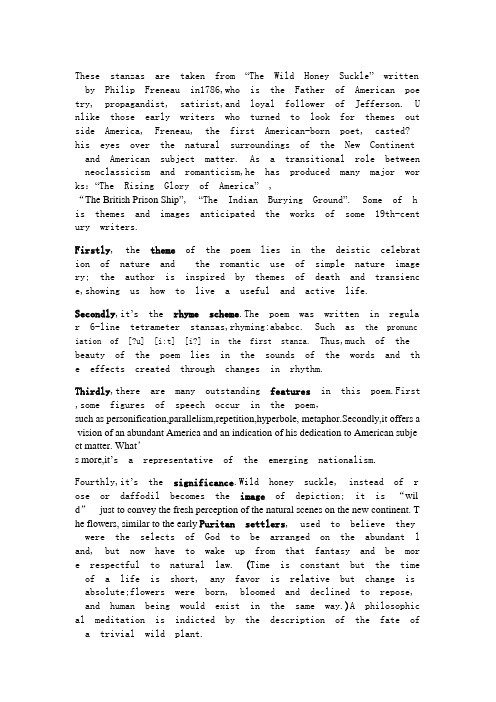
These stanzas are taken from “The Wild Honey Suckle” written by Phili p Freneau in1786,who is the Father of American poetry, propagandist, satirist,and loyal follower of Jefferson. Unlike those early writers who turned to look for themes outside America, Freneau, the first Ame rican-born poet, casted? his eyes over the natural surroundings of th e New Continent and American subject matter. As a transitional role b etween neoclassicism and romanticism,he has produced many major works :“The Rising Glory of America” ,“The British Prison Ship”, “The Indian Burying Ground”. Some of his them es and images anticipated the works of some 19th-century writers.Firstly, the theme of the poem lies in the deistic celebration of nat ure and the romantic use of simple nature imagery; the author is ins pired by themes of death and transience,showing us how to live a usef ul and active life.Secondly,it’s the rhyme scheme.The poem was written in regular 6-line tetrameter stanzas,rhyming:ababcc. Such as the pronunciation of [?u] [i :t] [i?] in the first stanza. Thus,much of the beauty of the poem lies i n the sounds of the words and the effects created through changes in rhythm.Thirdly,there are many outstanding features in this poem.First,some f igures of speech occur in the poem,such as personification,parallelism,repetition,hyperbole, metaphor.Secondly,it offers a vision of an abundant America and an indication of his dedication to American subje ct matter. What’s more,it’s a representative of the emerging nationalism.Fourthly,it’s the significance.Wild honey suckle, instead of rose or daffodil becomes the image of depiction; it is “wild”just to convey th e fresh perception of the natural scenes on the new continent. The flowers, similar to t he early Puritan settlers, used to believe they were the selects of God to be arranged on the abundant land, but now have to wake up from th at fantasy and be more respectful to natural law. (Time is constant b ut the time of a life is short, any favor is relative but change is a bsolute;flowers were born, bloomed and declined to repose, and human being would exist in the same way.)A philosophical meditation is indi cted by the description of the fate of a trivial wild plant.补充材料:First,It's personification.The poet used “thy” to describe the Wild Honey Suckl e.Second, It's parallelism. In the first stanza, the poet use “un” an d “no” to lead parallelism.Third, It's repetition.”If nothing once, you nothing lose”.Two nothings are repetition.Fourth,hyperbole. In the last sentence,an hour is too rapid of a flower like honey suckle to faded.Fifth, metaphor.From the first stanza fair flower to the end th e frail of a flower, the life of a flower just like the life of a hum an being. Our fate is doomed.。
美国文学
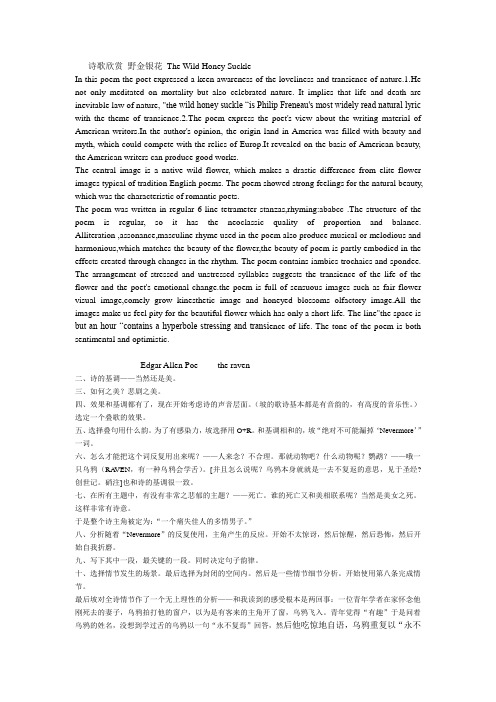
诗歌欣赏野金银花The Wild Honey SuckleIn this poem the poet expressed a keen awareness of the loveliness and transience of nature.1.He not only meditated on mortality but also celebrated nature. It implies that life and death are inevitable law of nature, "th e wild honey suckle “is Philip Freneau's most widely read natural lyric with the theme of transience.2.The poem express the poet's view about the writing material of American writors.In the author's opinion, the origin land in America was filled with beauty and myth, which could compete with the relics of Europ.It revealed on the basis of American beauty, the American writers can produce good works.The central image is a native wild flower, which makes a drastic difference from elite flower images typical of tradition English poems. The poem showed strong feelings for the natural beauty, which was the characteristic of romantic poets.The poem was written in regular 6-line tetrameter stanzas,rhyming:ababcc .The structure of the poem is regular, so it has the neoclassic quality of proportion and balance. Alliteration ,assonance,masculine rhyme used in the poem also produce musical or melodious and harmonious,which matches the beauty of the flower,the beauty of poem is partly embodied in the effects created through changes in the rhythm. The poem contains iambics trochaics and spondee. The arrangement of stressed and unstressed syllables suggests the transience of the life of the flower and the poet's emotional change.the poem is full of sensuous images such as fair flower visual image,comely grow kinesthetic image and honeyed blossoms olfactory image.All the images make us feel pity for the beautiful flower which has only a short life. The line"the space is but an hour “contains a hyperbole stressing and transi ence of life. The tone of the poem is both sentimental and optimistic.Edgar Allen Poe ------the raven二、诗的基调——当然还是美。
英美诗歌鉴赏
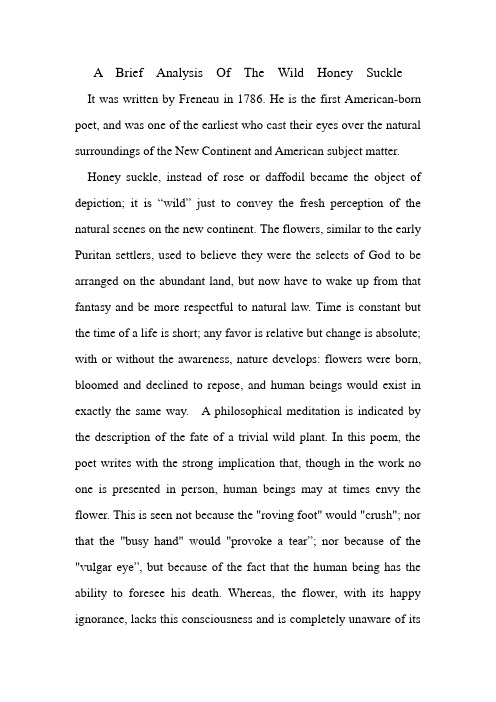
A Brief Analysis Of The Wild Honey SuckleIt was written by Freneau in 1786. He is the first American-born poet, and was one of the earliest who cast their eyes over the natural surroundings of the New Continent and American subject matter. Honey suckle, instead of rose or daffodil became the object of depiction; it is “wild” just to convey the fresh perception of the natural scenes on the new continent. The flowers, similar to the early Puritan settlers, used to believe they were the selects of God to be arranged on the abundant land, but now have to wake up from that fantasy and be more respectful to natural law. Time is constant but the time of a life is short; any favor is relative but change is absolute; with or without the awareness, nature develops: flowers were born, bloomed and declined to repose, and human beings would exist in exactly the same way. A philosophical meditation is indicated by the description of the fate of a trivial wild plant. In this poem, the poet writes with the strong implication that, though in the work no one is presented in person, human beings may at times envy the flower. This is seen not because the "roving foot" would "crush"; nor that the "busy hand" would "provoke a tear”; nor because of the "vulgar eye”, but b ecause of the fact that the human being has the ability to foresee his death. Whereas, the flower, with its happy ignorance, lacks this consciousness and is completely unaware of itsdoom. Its innocence left it happier than the foreseeing human beings. Unfortunately, the human beings are quite unwilling to refuse this knowledge and that arouses all their sufferings.1: the poem treats the advantages as well as the disadvantages of the flower's modest retirement—it is designed with beauty and well protected in solitude; whereas its beauty might be admired by few. 2: it suggests that the honey suckle bears a special relationship with nature which has advised it to keep away from the "vulgar eye"; Nature has designed it in white--a color of simplicity and purity, and, it has sent the soft waters flowing gently by. However, in spite of all the nature's kindness, the flower cannot escape its doom. The best time of its life is fading, for death is waiting.3: it reveals the indifference of nature—the "unp itying frosts” are as much a part of nature as the "soft waters". Thus, the notion that nature has provided a "guardian shade" for the protection of the honey suckle is a sentimental fancy. It is relative, but death is absolute.4: the poet sees his fate mirrored in that of the flower. Human beings, as any other creatures or flowers, are a part of nature. They originated from nature and will surely return to nature some day, thus their reduction to nature in the day ahead will constitute no real loss.I think we should fill our short life wisely because our life can only be worthy when we are still alive. When we are dead we are all just the same, just like the honey suckle. Therefore, to learn from all the experiences,to gain self-content in all the happenings,and to enjoy life from different angles,you will find your life worthwhile and meaningful. Only in this way, we can say that we are not a waste of our life.。
野金银花赏析
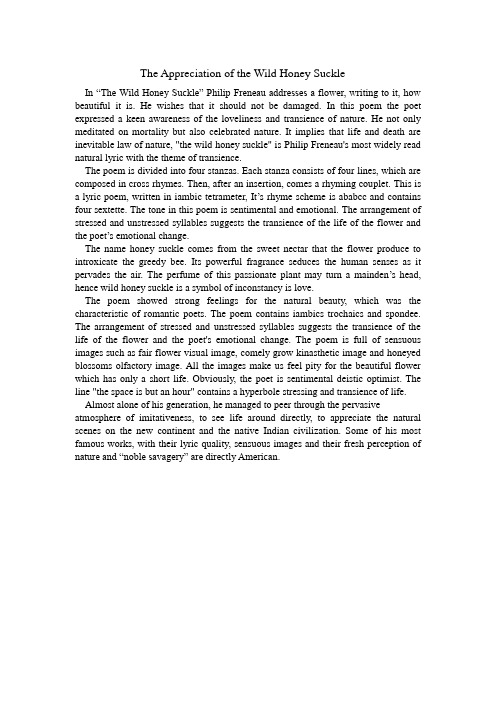
The Appreciation of the Wild Honey SuckleIn “The Wild Honey Suckle” Philip Freneau addresses a flower, writing to it, how beautiful it is. He wishes that it should not be damaged. In this poem the poet expressed a keen awareness of the loveliness and transience of nature. He not only meditated on mortality but also celebrated nature. It implies that life and death are inevitable law of nature, "the wild honey suckle" is Philip Freneau's most widely read natural lyric with the theme of transience.The poem is divided into four stanzas. Each stanza consists of four lines, which are composed in cross rhymes. Then, after an insertion, comes a rhyming couplet. This is a lyric poem, written in iambic tetrameter, It’s rhyme scheme is ababcc and contains four sextette. The tone in this poem is sentimental and emotional. The arrangement of stressed and unstressed syllables suggests the transience of the life of the flower and the poet’s emotional change.The name honey suckle comes from the sweet nectar that the flower produce to introxicate the greedy bee. Its powerful fragrance seduces the human senses as it pervades the air. The perfume of this passionate plant may turn a mainden’s head, hence wild honey suckle is a symbol of inconstancy is love.The poem showed strong feelings for the natural beauty, which was the characteristic of romantic poets. The poem contains iambics trochaics and spondee. The arrangement of stressed and unstressed syllables suggests the transience of the life of the flower and the poet's emotional change. The poem is full of sensuous images such as fair flower visual image, comely grow kinasthetic image and honeyed blossoms olfactory image. All the images make us feel pity for the beautiful flower which has only a short life. Obviously, the poet is sentimental deistic optimist. The line "the space is but an hour" contains a hyperbole stressing and transience of life. Almost alone of his generation, he managed to peer through the pervasive atmosphere of imitativeness, to see life around directly, to appreciate the natural scenes on the new continent and the native Indian civilization. Some of his most famous works, with their lyric quality, sensuous images and their fresh perception of nature and “noble savagery” are directly America n.。
翻译文化自觉论视角下《葬花吟》英译诠释

翻译文化自觉论视角下《葬花吟》英译诠释熊 俊内容摘要:从翻译文化自觉论视角对《葬花吟》霍杨两英译本进行全新解读,发现其差异的实质源于霍氏的译入语文化自觉和杨氏的源语文化自觉。
两译本无所谓孰优孰劣,只不过出于霍氏杨氏自己的文化自信自觉和翻译当下的社会文化语境所需采取了不同的翻译策略。
由此印证了翻译实践中译者的文化自觉意识至关重要。
这或可为当今的文学翻译提供借鉴。
关键词:翻译;文化自觉;《葬花吟》作者简介:熊俊,湖北工程学院外国语学院教授,泰国西那瓦大学博士研究生,研究方向为翻译学、符号学、文化研究。
Title: Interpretation on Two English Versions of Zang Hua Yin from the Perspective of Cultural ConsciousnessAbstract: Based on the concept of cultural consciousness in translation, this research attempts to make a new interpretation on the two English translations (the Yangs’ version and David Hawks’ version ) of Zang Hua Yin. After a comparison and thorough analysis, the author found that the differences between the two versions originate mainly from the two translators’ cultural consciousness of the source language. We cannot say that one translation is better than the other. It’s only due to the Yang’s and David Hawks’ cultural self-confidence and their own social and cultural context that greatly influence their choices of translation strategies. And it proves that the translator’s cultural consciousness is very important in translation practice. This may shed some light on today’s literary translation.Key words: translator; cultural consciousness; Zang Hua YinAuthor: Xiong Jun is professor at School of Foreign Languages, Hubei Engineering University (Xiaogan 432000, China) as well as Ph. D. candidate at Shinawatra University (Bangkok 10400, Thailand). Her research interest is translatology, semiotics and culture studies. E-mail: ****************《葬花吟》是《红楼梦》众多诗篇中的一经典之作,属典型的七言古体诗,出现在小说第二十七回“滴翠亭杨妃戏彩蝶,埋香冢飞燕泣残红”里。
野金银花诗歌鉴赏英文
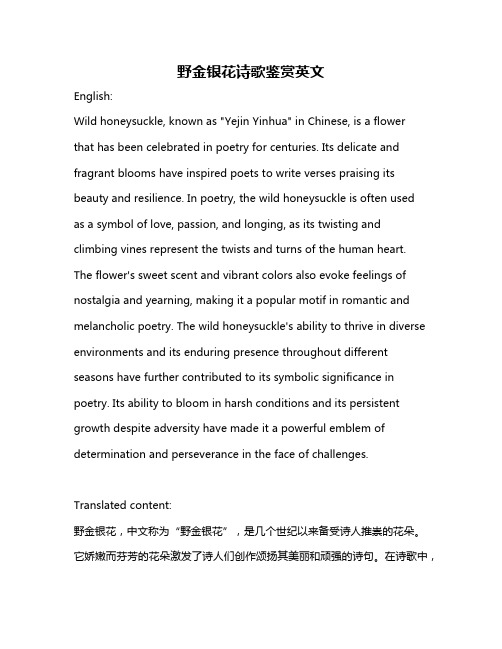
野金银花诗歌鉴赏英文English:Wild honeysuckle, known as "Yejin Yinhua" in Chinese, is a flowerthat has been celebrated in poetry for centuries. Its delicate and fragrant blooms have inspired poets to write verses praising its beauty and resilience. In poetry, the wild honeysuckle is often usedas a symbol of love, passion, and longing, as its twisting and climbing vines represent the twists and turns of the human heart.The flower's sweet scent and vibrant colors also evoke feelings of nostalgia and yearning, making it a popular motif in romantic and melancholic poetry. The wild honeysuckle's ability to thrive in diverse environments and its enduring presence throughout different seasons have further contributed to its symbolic significance in poetry. Its ability to bloom in harsh conditions and its persistent growth despite adversity have made it a powerful emblem of determination and perseverance in the face of challenges.Translated content:野金银花,中文称为“野金银花”,是几个世纪以来备受诗人推崇的花朵。
Analysis_of_The_Wild_Honey-Suckle[1]
IContentIn “The Wild Honey Suckle” Philip Freneau addresses a flower, writing to it, how beautiful it is. He wishes that it should not be damaged. He appreciates the skilfully planted wild honey suckle and its harmonic place within nature. Freneau also expresses his worries about the flower and compares it to those in paradise. He is aware of the flower’s fading and the short time that lies between growing and dying.Structure and FormThe poem is divided into four stanzas. Each stanza consists of four lines, which are composed in cross rhymes. Then, after an insertion, comes a rhyming couplet. The first four lines of each stanza describe the flower and address it. The last two lines show the fate of that flower. The rhythm is regular and iambic with four stressed syllables in each line. All cadences are male, except for those in the rhyming couplets of stanza three and four, which are female. The regularity of structure and form make the poem well-readable.ImageryPhilip Freneau employs a language full of imagery. Especially personifications constitute a main part of “The Wild Honey Suckle”. Moreover, the flower itself is personified. The narrator talks to theflower as if it were a human being. He expresses that the “little branches greet” (line 4), hopes that there will be no “tear” (6) of the flower and advices it to “shun the vulgar eye” (8). The “roving foot” and the “busy hand” (5f) are metaphors of the destruction of nature by men. Nature itself is personified as “Nature’s self” (7) which arraye d the flowers “and planted here the guardian shade and sent soft waters murmuring by” (9f). The waters are personified as well, being smooth and producing sounds like silent talking.Freneau was extremely sensitive to the beauties of nature. he expresses a keen awareness of the loneliness and transience of nature. Freneau personifies the flower in this poem to reflect how beautiful it is. The sounds of words effects created through changes in the rhythm. Especially in the last stanza he tells us the space between birth and death. The final verse to me is very comforting to those of us with little religious faith. It says simply, that death is like the time before birth. It is a non-existence that is not to be feared. Freneau describes the beauty of the flower very charmingly and sweetly. But at the same time, I can feel sorrow and loneliness of itself. And show the stern or hard realities of life and describe sensible way representing flower as real life.IIIn this poem the poet expressed a keen awareness of the loveliness andtransience of nature.He not only meditated on mortality but also celebr ated nature.It implies that life and death are inevitable law of nature,"th e wild honey suckle"is PhilipFreneau’s most widely read natural lyric with the theme of transience.The central image is a nativewild flower,which makes a drastic difference from elite flower images t ypical of tradition English poems.The poem showed strong feelings for the natural beauty,which was the characteristic of romantic poets.IIIThe poem was written in regular 6-line tetrameter stanza s. tetrameter n.四音步句;八音步诗adj.四音步的;八音步的stanzas 演出期;局;场;诗的一节The structure of the poem is regular, rhyming:ababcc,so it has the neoclassic quality of proportion and balance. Alliteration, assonance andmasculine rhyme used in the poem also produce musical or melodious and harmonious effects, which matches the beauty of the flower. Besides,the beauty of poem is partly embodied in the effects created thr ough changes in the rhythm.The poem contains iambic s,trochaic s and spondee.masculine adj. 阳性的;男性的;男子气概的embody vt. 体现,使具体化;具体表达iambics n.抑扬格;短长格adj.抑扬格、短长格的 trochaics [trəu'keiik] n. [诗]扬抑格诗句adj. [诗]长短格的;[诗]扬抑格的spondee n. [诗]扬扬格.The arrangement of stressed and unstressed syllables suggests the trans ience of the life of the flower and the poet's emotional change.The poem is full of sensuous images such as fair flower visual image, comely grow kinasthetic image and honeyed blossoms olfactory image. kinasthetic [,kinis'θetik, ,kai-]动觉的olfactory [ɔl'fæktəri] adj. 嗅觉的;味道的All the images make us feel pity for the beautiful flower which has onl y a short life. The tone of the poem is both sentimental and optimistic. Obviously the poet is a sentimental, deistic optimist.The line“the spacebetween, is but an hour”contains a hyperbole stressi ng and transience of life.。
于平凡之中见神奇_关于_野金银花_及其美学思想
注释: ¹ º » ( 作 者 译 ) 原 文 参 见 Geor geMcmichael; Ant hologyofAmer icanLiter ature , SecondEdition, Vloume1, PP 504- 505NewYor k, MacmillanPublishingCo·Inc·1980
刘晓晖
一
菲利普·弗瑞诺( PhilipFr eneau) 是一位在美国独立战争前后非常活 跃的诗人。他于 1752 年出生在纽约 的一个望族家庭, 曾就读于普林斯顿大学。在大学期间开始诗歌创作, 其诗歌充满了浓 厚民族色彩。1775 年美 国独立战争爆发时, 他在纽约写了大量抨击英国殖民压迫、充满爱国激情的诗章, 他因此获得了美国革 命诗人 ( P oetofTheAmer icanRevolution) 的称号, 并深得托马斯·杰佛逊( ThomasJefferson) 的赏识。1791 年在杰佛逊 的帮助下, 他创立并主编了《民族之声》( NationalGazette) 。该报成为支持杰佛逊改革 呼唤自由民主的喉舌。菲 利普 ·弗瑞诺的 名声鹤起 首先来自他 支持民主的 政论性新 闻文章, 他以自己 的笔墨和文 才为美国 民主政治 的建立作出了一定的贡献, 并为美国“平民时代”的到来起了推波助澜的作用。但是, 从十九世纪中叶开始, 菲 利普 ·弗瑞诺所 创作的诗 歌的价值逐 渐被人们所 认识, 他作为诗人 的名望因 此大大地超 过了他在 新闻工作 中的成 绩, 他被认 为是十八世纪美国最 重要的诗人, 甚至被称之为美 国诗歌之父。他的诗融合 了新古典主义 和浪漫主 义, 充满美 国情调, 其特 点在于具有浓厚的 抒情色彩, 运用明确的意象手法 , 并反映出 崇尚自然和原 始生活的倾向, 而这些特点成为十九世纪浪漫主义文学 的基本特 征。他的代表作 之一《野金银花》( TheWildHoneySuckle) 就是他自然神论的一个重要例证。在这首诗中诗人通过对大自然的赞美, 开创了十九世纪浪漫 主义文学采用意象主义手法的先河。
the wild honey suckle的分析(中英)
the wild honey suckle的分析《野金银花》是Freneau在南卡罗莱纳州查尔斯顿散步时,看到一簇幽生的金银花,于是便有感而发,将这首短诗一气呵成。
诗人以敏锐的观察力、浅俗的词汇、优美的旋律和清晰的意象,细腻生动地描写了盛开于北美大地不为人们注意的野金银花。
此诗分为两大部分,前两节写景,后两节抒情。
写景以抒情为目的,抒情以写景为背景,两部分互为烘托,成为不可分割的整体。
诗人以惊喜的目光看到自然界神奇的产物时,心中涌动的是对大自然无限的崇拜之情。
如果说“绿荫”指的是未受人类文明侵犯的新大陆处女地的话,那些“美丽的金银花”则应是大自然创作的生命的具体体现。
诗人用浅显的文字勾画出一片繁荣祥和的景象,在对生命的赞叹中,流露出返璞归真、崇尚自然的情节,充满了浪漫主义情调和理想主义色彩。
然而,Freneau的过人之处,不仅在于他具有诗人的敏感,而且在于他同时具有哲人的睿智。
诗人先是描写外界景物,然后直接联系到自己,联系到人类,并将人与自然融为一体,以自然规律来感染读者。
所以,诗人从第三小节开始笔锋一转。
显然,诗人对大自然的神奇力量由崇拜转为迷惑,怀着惋惜忐忑的心情联想到生命的无奈和大自然的无情,开始了对生命本质的思考。
因此,在第四小节,诗人对主题进一步挖掘。
至此,Freneau借助金银花的荣枯阐述了自己毫不掩饰的自然观:万物有生必有死,有荣必有枯,花开花落,四季转换乃自然界的规律,这一规律是不以人的意志为转移的,是人类无法抗拒的。
自然界万物的生生息息乃自然的神力所造就,是人类无法左右的。
因而,对于花的荣枯,人的生死,人类大可不必为之伤情。
正如中国的一句古语,人“生不带来死不带去”。
诗人高歌:“不曾拥有,何曾失去”,足以说明诗人对生命本质有了明确的认识后,走出困惑,最终达到一种豁达乐观的境界。
Freneau以他对美洲大地的深厚感情和洞若幽微的感受力,通过对金银花的生长环境及其盛衰变迁的描述,抒发了他对短暂人生的感叹,使本诗在清丽的意境和浓郁的美洲大地的乡土气息中加入一层哲理的思考。
The wild honey suckle
Smit with those chams, that must decay, I grieve to see your future doom; They died--nor were those flowers more gay, The flowers that did in Eden bloom;
Questions
1)How do you interpret the symbolical meaning of the wild honey suckle?
To understand this poem better, we should understand the most important characteristics of honey suckle, i.e. its beautiful colours its rich fragrance, its rampant growth, and its frailty. This kind of flower usually grows in remote areas (forests, swamps, or hills). These key words—beautiful, fragrant, frail, and hidden—are the soul of this poem.
- 1、下载文档前请自行甄别文档内容的完整性,平台不提供额外的编辑、内容补充、找答案等附加服务。
- 2、"仅部分预览"的文档,不可在线预览部分如存在完整性等问题,可反馈申请退款(可完整预览的文档不适用该条件!)。
- 3、如文档侵犯您的权益,请联系客服反馈,我们会尽快为您处理(人工客服工作时间:9:00-18:30)。
• Smit with those charms, that must decay, I grieve to see your future doom; They died--nor were those flowers more gay, The flowers that did in Eden bloom; Unpitying frosts, and Autumn's power Shall leave no vestige of this flower.
Figures of Speech
• Apostrophe [ə’pɔstrəfi] (呼语) --- ”fair flower” • Personification--- “dost”, “you”, “she” • Alliteration—”fair flower” ”blossoms blow” • Parallelism, synecdoche---”untouched thy
• From morning suns and evening dews At first thy little being came: If nothing once, you nothing lose, For when you die you are the same; The space between, is but an hour, The frail duration of flower.
smit: past tense of “smite” smit with: impressed by, stricken by; unpitying: cruel, merciless vestige: trace
• Smit with those charms, that must decay, I grieve to see your future doom; They died--nor were those flowers more gay, The flowers that did in Eden bloom; Unpitying frosts, and Autumn's power Shall leave no vestige of this flower.
• Stanza 3: it reveals the indifference of nature—the "unpitying frosts” are as much a part of nature as the "soft waters". Thus, the notion that nature has provided a "guardian shade" for the protection of the honey suckle is a sentimental fancy. It is relative, but death is absolute.
• ﹀ \ ﹀ \ ﹀ \﹀\
• Hid in this silent, dull retreat
• ﹀ \ ﹀ \﹀ \ ﹀ \
• Untouch'd thy honey'd blossoms blow,
•﹀ \
﹀\ ﹀ \ ﹀ \
• Unseen thy little branches greet:
• To understand this poem better, we should understand the most important characteristics of honey suckle: its beautiful colours, its rich fragrance, its rampant growth, and its frailty. This kind of flower usually grows in remote areas (forests, swamps, or hills).
Nature: personification (she) in white array’d: dressed in white; purity bade: past tense of “bid”; command, ask shun: avoid summer: metaphor repose: rest
• Fair flower, that dost so comely grow, Hid in this silent, dull retreat, Untouch'd thy honey'd blossoms blow, Unseen thy little branches greet: No roving foot shall crush thee here, No busy hand provoke a tear.
• Four six-line stanzas • RHYME: ababcc • Rhythm: iambic tetrameter
Rhythm or Metrical pattern: iambic
tetrameter
• Fair flower, that dost so comely grow
• Stanza 1: the poem treats the advantages as well as the disadvantages of the flower's modest retirement—it is designed with beauty and well protected in solitude, whereas its beauty might be admired by few.
Analysis of “The Wild Honey Suckle”
The Wild Honey Suckle
What is a Honeysuckle?
• It is one of the most beautiful of all wildflowers, marked by its scent (香味)and ability to grow in difficult places.
honeyed blossoms blow/ unseen thy little branches greet” • Metaphor--- Thus quietly thy summer goes • Hyperbole--- The space between, is but an hour
The Wild Honey Suckle
The Wild Honey Suckle
• Fair flower, that dost so comely grow, Hid in this silent, dull retreat, Untouch'd thy honey'd blossoms blow, Unseen thy little branches greet: No roving foot shall crush thee here, No busy hand provoke a The Wild Honey Suckle” describes a beautiful flower growing in a secluded place, less known and less honored by people. And when Autumn comes, the flower dies quietly and unknowingly. The whole life of the flower is short and it comes from nowhere and goes nowhere. It seems to be the natural law for everything to die in the world.
• By Nature's self in white arrayed, She bade thee shun the vulgar eye, And planted here the guardian shade, And sent soft waters murmuring by; Thus quietly thy summer goes, Thy days declining to repose.
Stanza 2: it suggests that the honey suckle bears a special relationship with nature which has advised it to keep away from the "vulgar eye"; Nature has designed it in white--a color of simplicity and purity, and, it has sent the soft waters flowing gently by. However, in spite of all the nature's kindness, the flower cannot escape its doom. The best time of its life is fading, for death is waiting.
retreat: place of seclusion; secluded place greet: personification No roving foot shall crush thee here, / No busy hand provoke a tear: iteration: parallelism; personification; synecdoche; provoke: stir up; cause to shed;
• By Nature's self in white arrayed, She bade thee shun the vulgar eye, And planted here the guardian shade, And sent soft waters murmuring by; Thus quietly thy summer goes, Thy days declining to repose.
